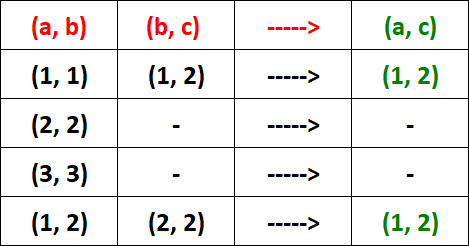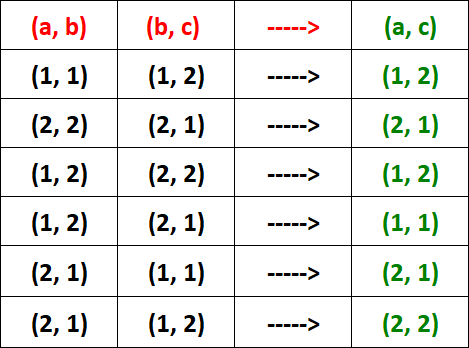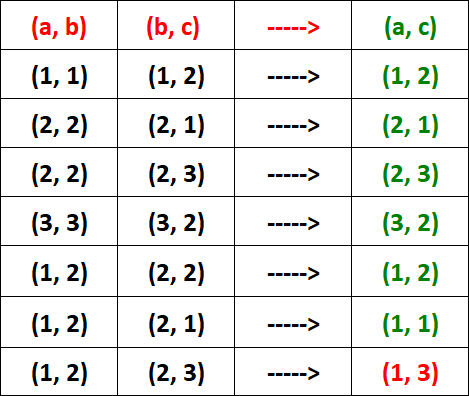TRANSITIVE RELATION
Subscribe to our ▶️ YouTube channel 🔴 for the latest videos, updates, and tips.
Let us consider the set A as given below.
A = {a, b, c}
Let R be a transitive relation defined on the set A.
Then,
R = { (a, b), (b, c), (a, c)}
That is,
If "a" is related to "b" and "b" is related to "c", then "a" has to be related to "c".
In simple terms,
a R b, b R c -----> a R c
Example :
Let A = { 1, 2, 3 } and R be a relation defined on set A as "is less than" and R = {(1, 2), (2, 3), (1, 3)} Verify R is transitive.
Solution :
From the given set A, let
a = 1
b = 2
c = 3
Then, we have
(a, b) = (1, 2) -----> 1 is less than 2
(b, c) = (2, 3) -----> 2 is less than 3
(a, c) = (1, 3) -----> 1 is less than 3
That is, if 1 is less than 2 and 2 is less than 3, then 1 is less than 3.
More clearly,
1R2, 2R3 -----> 1R3
Clearly, the above points prove that R is transitive.
Important Note :
For a particular ordered pair in R, if we have (a, b) and we don't have (b, c), then we don't have to check transitive for that ordered pair.
So, we have to check transitive, only if we find both (a, b) and (b, c) in R.
Solved Problems
Problem 1 :
Let A = {1, 2, 3} and R be a relation defined on set A as
R = {(1, 1), (2, 2), (3, 3), (1, 2)}
Verify R is transitive.
Solution :
To verify whether R is transitive, we have to check the condition given below for each ordered pair in R.
That is,
(a, b), (b, c) -----> (a, c)
Let's check the above condition for each ordered pair in R.

From the table above, it is clear that R is transitive.
Note :
For the two ordered pairs (2, 2) and (3, 3), we don't find the pair (b, c). So, we don't have to check the condition for those ordered pairs.
Problem 2 :
Let A = {1, 2, 3} and R be a relation defined on set A as
R = {(1, 1), (2, 2), (1, 2), (2, 1)}
Verify R is transitive.
Solution :
To verify whether R is transitive, we have to check the condition given below for each ordered pair in R.
That is,
(a, b), (b, c) -----> (a, c)
Let's check the above condition for each ordered pair in R.

From the table above, it is clear that R is transitive.
Problem 3 :
Let A = {1, 2, 3} and R be a relation defined on set A as
R = {(1, 1), (2, 2), (3, 3), (1, 2), (2, 1), (2, 3), (3, 2)}
Verify R is transitive.
Solution :
To verify whether R is transitive, we have to check the condition given below for each ordered pair in R.
That is,
(a, b), (b, c) -----> (a, c)
Let's check the above condition for each ordered pair in R.

In the table above, for the ordered pair (1, 2), we have both (a, b) and (b, c). But, we don't find (a, c).
That is, we have the ordered pairs (1, 2) and (2, 3) in R. But, we don't have the ordered pair (1, 3) in R.
So, we stop the process and conclude that R is not transitive.
Related Topics
Difference between reflexive and identity relation
Subscribe to our ▶️ YouTube channel 🔴 for the latest videos, updates, and tips.
Kindly mail your feedback to v4formath@gmail.com
We always appreciate your feedback.
About Us | Contact Us | Privacy Policy
©All rights reserved. onlinemath4all.com
Recent Articles
-
AP Calculus BC Problems with Solutions
Dec 20, 25 10:51 AM
AP Calculus BC Problems with Solutions -
AP Precalculus Problems and Solutions (Part - 1)
Dec 20, 25 10:49 AM
AP Precalculus Problems and Solutions (Part - 1) -
AP Calculus AB Problems with Solutions (Part - 1)
Dec 20, 25 10:49 AM
AP Calculus AB Problems with Solutions (Part - 1)
